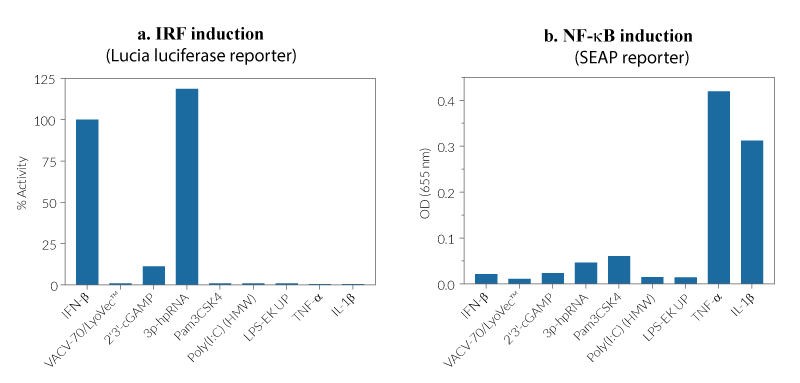HepG2-Dual™ Cells
| Product | Unit size | Cat. code | Docs. | Qty. | Price | |
|---|---|---|---|---|---|---|
|
HepG2-Dual™ Cells NF-κB-SEAP & IRF-Lucia reporter liver carcinoma cells |
Show product |
3-7 x 10e6 cells |
hepg2d-nfis
|
|
||
|
HepG2-Dual™ vial Additional cell vial |
Show product |
3-7 x 10e6 cells |
hepg2d-nfis-av
|
Notification:
Reference #hepg2d-nfis-av can only be ordered together with reference #hepg2d-nfis.
NF-κB-SEAP & IRF-Lucia reporter liver carcinoma cells
The human hepatocellular carcinoma cell line HepG2 is widely used for in vitro studies of infection with hepatitis viruses (except HBV & HCV) and other hepatotropic pathogens such as Human Cytomegalovirus, Dengue Virus, Brucella and Listeria [1, 2].
HepG2-Dual™ cells are designed for the study of NF-κB and IRF (interferon regulatory factor) pathways. NF-κB activation can be assessed by measuring secreted embryonic alkaline phosphatase (SEAP) activity, while the IRF pathway can be monitored by following Lucia luciferase activity.
Anti-viral and anti-bacterial immune responses mostly rely on the recognition of viral nucleic acids by cytosolic Toll-like receptors (TLRs), cytosolic RIG-I-like receptors (RLRs), and cytosolic DNA sensors (CDS). The TLR expression and activation profile of HepG2 cells are still poorly characterized, but it is established that HepG2 cells express the RIG-I and MDA-5 RNA sensors [2,3]. Although they do not express the cyclic GMP-AMP synthase (cGAS) cytosolic DNA sensor, these cells express low levels of its adaptor protein, STING (stimulator of interferon genes, also known as MITA) [4]. A moderate IRF response is detected in HepG2-Dual™ cells upon incubation with STING agonists such as 2’3’-cGAMP, while the 3p-hpRNA RIG-I agonist, induces a strong IRF response.
Both SEAP and Lucia luciferase reporter proteins are readily measurable in the cell culture supernatant when using QUANTI-Blue™ Solution and QUANTI-Luc™ 4 Lucia/Gaussia respectively.
HepG2-Dual™ cells are resistant to blasticidin and Zeocin®.
References:
1. Gural N. et al. 2017. Engineered livers for infectious diseases. Cell Mol Gastroenterol Hepatol. 5:131-44.
2. Yin X. et al. 2017. Hepatitis E virus persists in the presence of a type III interferon response PLoS Pathog. 13(5):e1006417.
3. Sato S. et al. 2015. The RNA sensor RIG-I dually functions as an innate sensor and direct antiviral factor for hepatitis B virus. Immunity. 42(1):123-32.
4. Dansako H. et al., 2016. The cyclic GMP-AMP synthetase-STING signaling pathway is required for both the innate immune response against HBV and the suppression of HBV assembly. FEBS J. 2283(1):144-56.
Specifications
Antibiotic resistances: Zeocin®, blasticidin
Quality Control:
- Reporter activity has been verified by functional assays.
- The stability of this cell line for 20 passages following thawing has been verified.
- HepG2-Dual™ cells are guaranteed mycoplasma-free.
Contents
- 3-7 x 106 of HepG2-Dual™ cells in a cryovial or shipping flask
- 1 ml Zeocin® (100 mg/ml)
- 1 ml Blasticidin (10 mg/ml)
- 1 ml Normocin™ (50 mg/ml), a formulation of three antibiotics active against mycoplasmas, bacteria, and fungi.
- 1 ml of QB reagent and 1 ml of QB buffer (sufficient to prepare 100 ml of QUANTI-Blue™ Solution, a SEAP detection reagent).
- 1 tube of QUANTI-Luc™ 4 Reagent, a Lucia luciferase detection reagent (sufficient to prepare 25 ml)
![]() Shipped on dry ice (Europe, USA, Canada, and some areas in Asia)
Shipped on dry ice (Europe, USA, Canada, and some areas in Asia)






